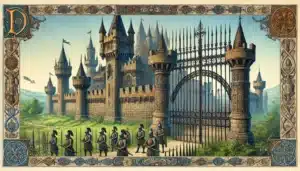Imagine a serene meadow, kissed by the morning sun, its tranquility only punctuated by the chirping of birds and the gentle rustle of leaves. At its edge, a sturdy yet elegantly simple fence runs, its wooden posts and dowels standing like silent sentinels. This is more than a boundary; it’s a harmonious blend of nature and craftsmanship. The fence, with its natural wood tones, doesn’t just mark the perimeter of the meadow but enhances its beauty, adding a rustic charm that speaks of tradition and a deep respect for the natural world.
Post and dowel fencing, a timeless classic in the world of boundary solutions, is characterized by its simplicity and robustness. It consists of rounded posts and dowels, which fit snugly into holes drilled into the posts, creating a fence that is both functional and aesthetically pleasing. Unlike its more opulent counterparts, the beauty of a post and dowel fence lies in its understated elegance and the way it complements the natural environment. It’s a blend of form and function, providing sturdy and reliable boundaries while maintaining an aesthetic that feels organic and unobtrusive.
In this blog, we delve into an often-overlooked perspective: viewing fence installation not merely as a practical task but as an art form, a reflection of personal style and a canvas for self-expression. The creation of a post and dowel fence is not just about erecting a barrier; it’s about crafting a personal statement, a signature that reflects one’s taste and complements the surrounding landscape. It’s about turning a simple boundary into a creative masterpiece that stands as a testament to one’s connection with their environment.
The Artistry of Post and Dowel Fencing
Design Considerations
The art of creating a post and dowel fence begins with choosing the right materials. The type of wood, be it cedar, pine, or oak, not only determines the durability and longevity of the fence but also its aesthetic appeal. The spacing of the posts and the pattern of the dowels are crucial elements that dictate the overall look and feel of the fence. A closer spacing offers a sense of privacy and seclusion, while wider spacing allows glimpses of the landscape beyond, creating a sense of openness.
Personal Expression
A post and dowel fence is a canvas for homeowners to express their personality and complement their home’s architectural style. Whether it’s a rustic look for a country cottage or a more polished finish for a modern home, the fence can be customized to reflect individual tastes. Creative designs, such as varying the height of the posts or incorporating intricate dowel patterns, can transform a simple fence into a striking feature of the property.
Integration with Landscaping
More than just a boundary, a post and dowel fence can be an integral part of the landscape design. It can frame a beautiful garden, creating natural ‘windows’ that offer views of specific sections, or it can be used to create a sense of rhythm and flow in the landscape. Incorporating climbing plants or integrating the fence with existing trees and shrubs can further enhance this connection, making the fence a living part of the garden’s tapestry.
Step-by-Step Guide to Installing a Post and Dowel Fence
Pre-Installation Planning: Laying the Groundwork
Before the first post is ever set, the art of fence installation begins with meticulous planning. This phase is crucial for ensuring a smooth, enjoyable process and a beautiful result.
- Understanding Local Regulations: Your creative vision must align with local building codes and regulations. Check with your local municipality for any restrictions or permits required for fence construction.
- Choosing Your Materials: Selecting the right wood is like choosing the paint for a masterpiece. Consider weather-resistant woods like cedar or redwood for their longevity and natural beauty. Also, decide on the diameter of the posts and dowels to match the scale of your landscape.
- Site Preparation: Clear the fence line of any debris or obstructions. If you’re replacing an old fence, ensure the area is clean and ready for the new installation.
The Installation Process: A Journey of Creation
Now comes the exciting part – bringing your vision to life. Each step in this process is an opportunity to infuse your personal touch into this functional piece of art.
- Marking the Layout: Carefully measure and mark where each post will go. The spacing between the posts is crucial for both structural integrity and aesthetic appeal. Consider using a string line to ensure straight lines.
- Digging Post Holes: Dig holes for your posts, ideally around 2 feet deep, or about 1/3 the height of your post for stability. Adding a layer of gravel at the bottom can aid drainage and prevent wood rot.
- Setting the Posts: Place your posts in the holes and use a level to ensure they are perfectly vertical. Mix and pour concrete around the base for a secure setting. Let the concrete cure as per manufacturer instructions, adding your personal touch by carving initials or designs in the still-wet concrete.
- Installing the Dowels: Once the posts are set, drill holes for the dowels. The creativity lies in the pattern and arrangement of the dowels – play with different designs for a unique look.
- Adding the Dowels: Insert the dowels into the pre-drilled holes. You might choose to paint or stain the dowels beforehand for an added color accent or leave them natural for a more organic feel.
- Finishing Touches: Apply a sealant to protect the wood from the elements. Here, too, you can be creative – choose a finish that enhances the natural grain of the wood or opt for a colored stain to match your landscape.
Safety Tips: Crafting with Care
As you embark on this creative journey, remember to prioritize safety.
- Wear protective gear like gloves and safety glasses.
- When digging, be mindful of any underground utilities.
- Always use tools and materials as instructed.
- Keep a first aid kit handy.
Above all, remember to enjoy the process. Installing a post and dowel fence is not just about building a boundary; it’s about crafting a part of your home’s story, a physical manifestation of your creative vision and effort. Take pleasure in the journey as much as in the beautiful, enduring result.
The Benefits of Post and Dowel Fencing
Environmental Friendliness: Embracing Sustainability
Post and dowel fencing stands out for its environmental stewardship. Using sustainably sourced wood, such as locally harvested timber or woods from certified sustainable forestry practices, minimizes the ecological footprint. This type of fencing champions the use of natural, renewable resources, offering a green alternative to synthetic fencing materials. The ability to use less treated woods also contributes to a healthier ecosystem, ensuring that your fence harmonizes with nature, not only in aesthetics but also in spirit.
Read More: Eco-Friendly Fencing Options for the Conscious Homeowner
Durability and Maintenance: Rustic Yet Resilient
Despite its seemingly simple and rustic appearance, post and dowel fencing is a paragon of durability. Woods like cedar and redwood naturally resist decay and pests, ensuring longevity with minimal intervention. These fences can withstand harsh weather conditions, making them a steadfast guardian of your property. Maintenance is often as simple as occasional cleaning and applying protective stains or sealants every few years. Tips for longevity include choosing the right wood finish and performing regular inspections to catch any issues early.
Psychological Impact: A Sense of Place and Security
A well-crafted post and dowel fence does more than define boundaries; it enhances one’s sense of home and personal space. There’s a profound psychological comfort in the solid, yet unimposing presence of these fences. They create a safe, enclosed space for families to relax, contributing to a feeling of security and privacy. Moreover, their natural and harmonious appearance can have a calming effect, making your home not just a place to live, but a sanctuary.
Beyond Practicality: Emotional and Social Aspects
Community Connection: Building Bonds
The process of installing a post and dowel fence can be a community-building experience. It’s not uncommon for neighbors to bond over shared fence projects, exchanging stories, and skills. These fences can become a focal point for neighborhood conversations and connections, fostering a sense of community and belonging.
Historical and Cultural Significance: Ties to Tradition
Post and dowel fencing has roots in various regional histories and cultural practices. This fencing style echoes the traditional techniques used in rural and pastoral communities, making it a nod to heritage and craftsmanship. By choosing this style, you’re not just erecting a boundary; you’re preserving a piece of cultural history and connecting with past generations.
Conclusion
In conclusion, post and dowel fencing offers a unique blend of artistic and practical benefits. It’s a testament to sustainability, durability, and personal expression. As we’ve explored, these fences are more than mere boundaries; they are storytellers, keepers of history, and catalysts for community connection.
We invite you to view fence building not just as a task, but as an opportunity for artistic expression and a deeper connection with your surroundings. Share your post and dowel fence designs or plans with us, and join a community of creative home improvement enthusiasts who see beyond the practicalities to the art and heart in every fence.



